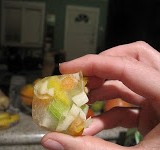Erik sourced some nice grapefruits from our friend’s tree and used the flesh to do some homework for his Master Food Preserver program. This left a big pile of organic, unwaxed grapefruit rind on our counter, so I decided to do something about it, and set off to make candied grapefruit peel. This is the technique I came up with by mashing together a bunch of different internet recipes and making two batches of the stuff. The results are delish if a bit rustic in appearance. I don’t think I’d pass muster at French pastry school with my lazy technique, but Erik and I like them a lot.
You must genuinely love grapefruit, the bitterness of it, to appreciate these. If you’re not a grapefruit fan, I’m sure this would work with orange rind as well. If you are a grapefruit fan, you’ll find yourself sneaking off to the candy jar for a little more that sweet-bitter flavor punch.
We’ve been snacking on them straight, but I think they’d be really good chopped into small pieces and sprinkled over vanilla ice cream or folded into scones or dipped in chocolate. I like them as straight-up candy because they’re so intense they satisfy restless cravings, but for the same reason you can’t gorge on them. Actually, I can’t eat more than two at a time. The how-to after the break.
The Technique
I’m calling this a technique and not a recipe. Grapefruits vary in size, peel thickness and bitterness, so results are going to vary.
This is a good thing to do when you’re working in the kitchen anyway, because it takes time, but not tons of attention.
- Chop your rind into any shape you want. I cut mine into rough strips about 1/3-1/2″ wide and and 2″ long, though there were lots of smaller pieces, too. You don’t have to trim off the white pith. Thank goodness, huh? If it’s ridiculously thick, as it can be sometimes, feel free to carve some of it away as you work. Pieces with huge chunks of pith on them will be slower to cook and dry than the rest. I guess what I’m saying is that standardization leads to consistency. Not that it matters a lot.
- Put the cut up peel in a saucepan, cover with water, bring to a boil, pour off the water. Refill and bring to a boil again. Boil four times total. This doesn’t take as long as you’d think. The boiling reduces some of the bitterness in the peel.
 |
| boiled grapefruit peel |
- Use about 1/2 cup of sugar for every grapefruit. Pour the sugar into a saucepan large enough to hold the peel. Add half as much water as sugar and stir to dissolve. Add the drained peels and begin to cook over medium heat, stirring occassionally. e.g. 2 grapefruit = 1 cup sugar + 1/2 cup water. My batches were made with 5 small grapefruits and 2 cups of sugar. (Obviously you can play with the amount of sugar–something with little pith, like a thin skinned orange, would need less. And maybe a “lite” version is possible. Try and see.)
- Cook the peels over medium heat. They will soften and turn transparent. Meanwhile, the sugar syrup will thicken and reduce. Keep cooking until the sugar syrup is so thick and so reduced that its mostly just coating the rinds, and the rinds themselves are golden and clear like tiny stained glass windows. Be sure to stir lots at the end so it doesn’t burn. This process took an hour in my case. It may have gone faster over higher heat. It would also go faster with a smaller batch.
 |
| Cooking down the syrup |
- Turn the peels out onto an oiled rack to cool and drip off any excess syrup. (Lacking a rack, I ended up spreading mine over the bottom of colanders, which wasn’t a ton of fun, but worked.) Let them stay there until they lose their wet stickiness. How long will vary–overnight, at least, I’d say. At that point you can sugar them if you want yet more sugar. It looks nice. Put the sugar on too soon and it will be absorbed into the syrup. When they’re totally dry, store them away in something air-tight.
 |
| When almost all the syrup was gone/absorbed, as it looks here, I spread out the pieces to cool. |






I’ve just learned about another use for citrus peels – put them in the white vinegar that you use for your household cleaning. It makes the vinegar smell wonderful! And, I think adds to it’s cleaning power.
(I love candied grapefruit peel, so would do that. Alas, here on the East Coast we don’t have affordable organic grapefruit hanging from trees in our yards.)
Ah! I like that idea! I’ve heard of adding herbs to vinegar for the same reasons. I don’t know if they boost the disinfectant power in any real sense or not, but it may be worth doing just for the scent.
Another thing we’ve learned lately is that you can make jelly with citrus peels alone–one of many things Erik is picking up in his master food preserver class. I’ll see if I can get him to blog about it.
Just like my great grandmother made, my grandmother, my mother, and me. I love them.
Oh, YUM! They are pretty too!
These look great! I might have to hunt down some grapefruit and try this out 🙂
Sticking with the Asian theme, Buddha’s hand citrus is great to do this with because of the sweet rind that it has. It’s pretty common in China.
I’m also going to be experimenting with buddha’s hand rinds for its pectin because I hear that pectin derived from citrus rinds is better for jamming with honey (sans sugar) than other pectins. I just picked up a great book on jamming with honey but it doesn’t discuss citrus pectin, so I’ll have to play with it when my fruit start to come in and my honey starts to flow.
Yum! I am now wishing I had not thrown my grapefruit rind in the compost bin just a few minutes ago…
We just did this with ginger and it was wonderful. We also got some wonderful ginger syrup in the process which we have used to sweeten our homemade yogurt, in mashed yams and I used it to sweeten my chia tea. I’d love to try some citrus peel now.
I was thinking about ginger. It’s so good candied, isn’t it? I thought about throwing some piece in, but it wouldn’t go with grapefruit–but I bet it would be really good with orange peel.
“[R]estless cravings” hmmm? You could elaborate since this sounds interesting.
I was wondering about the grapefruit rind and fungicide/pesticide problems. Then, I saw organic. I doubt there is any organice grapefruit in this town. If so, the price would be exorbitant. Really, I know a price cannot be put on our health! How much are organic grapefruits there? Or, are they free from your trees or from friends’ trees?
We’re lucky to live where organic citrus is inexpensive–don’t know the price per pound. But better yet, there are a lot of citrus trees in the neighborhood.
If you choose to remove the thick pith from the grapefruit peel next time before candying the peel, please be aware that you can also candy the pith separately. The recipe is here. I’ve tried it and it’s tasty. The pith does retain some of its spongy quality but the sweet cinnamon flavor is good on crisp crackers, with or without a creamy cheese spread on them as well.
We do this with our lemon skins. Too nice so it doesn’t last long here. I also add some to the vinegar and use it as a deodarent as well as cleaning
Barb.
I have a bunch of grapefruit skins I want to preserve. All the recipes I read say that one should bring the skins and water to the boil, toss the water, add new water and bring to the boil again. Do this 3 – 4 times and it will remove the bitter taste.
How long would these candied graperuit peels last?
For long term storage I’d keep the candied peel in the freezer. How long exactly it would last at room temp is going to depend on the local conditions, and that’s going to vary a lot. What I know is that left at room temp here (warm, dry) they’re okay for week or two, then they start to lose texture and get sticky, and eventually go moldy.